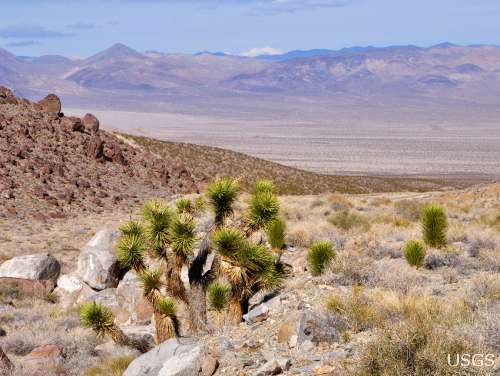Joshua trees, the spiky desert-dwellers that are so iconic to Southern California’s dry country that they got a national park named after them, will likely disappear from 90% of their current range by the end of the century, according to a new study by scientists at the US Geological Survey.
Ecologist Ken Cole, the study’s lead author, said that means no more Joshua Trees in Joshua Tree National Park, which is currently in the southernmost part of the species’ range. It also means elimination of the trees across wide swathes of other parts of Southern California as well as Nevada and Arizona.
Cole and his team used climate models, field work, and the fossil record to project the future distribution of Joshua trees. They compared the projected increase in temperatures for the Southwest (four degrees Celsius, according to a “middle of the road” IPCC scenario) to a similar rapid increase in temperatures nearly 12,000 years ago, at the end of the ice age.
Using fossil sloth dung and packrat midden, the scientists reconstructed how Joshua trees responded to that warming. (Sloths, which are now extinct in the region, and packrats, ate the Joshua tree fruit, spreading the seeds and leaving them behind for the scientists to track.)
“Sometimes the climate changes rapidly, like it did 11,700 years ago,” said Cole. “At that time the Joshua trees squashed into a narrow band at the northern edge of their range. That’ll happen again. The southerly ones will not be able to persist.”
This loss of southern territory is particularly significant for a species like the Joshua Tree, which has a “pretty pitiful” expansion rate, according to Cole. That’s because, unlike the Ponderosa pine, which can expand its range 500 meters a year thanks to birds and other factors, the range of Joshua trees can stretch just about six feet per year.
“They don’t release their seeds until some animal chomps on them,” said Cole, referring to the fruit of the Joshua tree. “They’re spread by squirrels and pack rats that might run 100 feet and stash some seeds in the ground. Some of them might grow, but it could take 20, 30, or 40 years. Going 100 feet every 20 years is not moving as quickly as it needs to to keep up with climate change.”
Researchers mapped where in the Southwest Joshua trees are currently located, where they are likely to disappear, and where they will likely persist (small pockets in Nevada and in southeastern California). They also mapped where future climate will likely be suitable for the trees, should anyone want to undertake a program of managed relocation. But even that, said Cole, has its risks.
“We don’t know how well they would grow then,” he said. “Joshua trees are very picky.”
Not only that, but relocating the trees would be expensive, and he said, “You’d have to assume that the climate wouldn’t change again. That’s a really bad assumption.”
Cole says his field observations support the study’s projections. Temperatures in the region have been warming since 1975, he said, and there’s no record of Joshua trees reproducing in the southern stands in the last 30 years.
“You don’t see any seedlings or saplings in the southern stands,” said Cole.
That’s a big contrast to the northerly stands in the Inyo Mountains above Eureka Valley, where, he said, Joshua trees are thriving.
“The ones in the north are really vigorous,” he said. “They’re going like mad.”
The full study is located on the Ecology Society of America’s website, but a subscription is required to access it.
Read more on climate change impacts facing the national parks.
One thought on “Joshua Trees Losing Ground, Fast”
Comments are closed.


Thank you. That was very interesting.